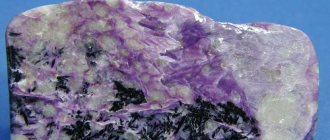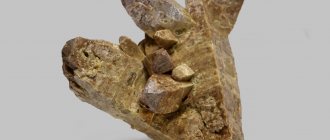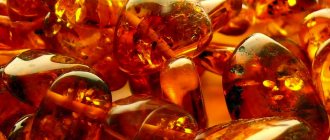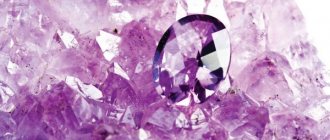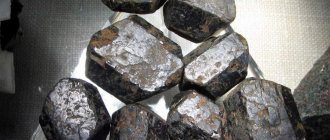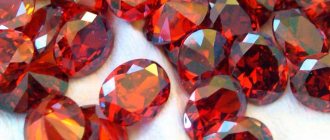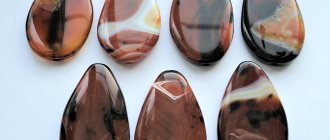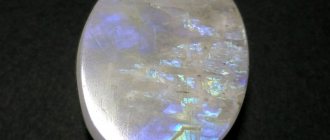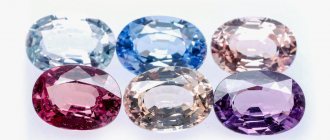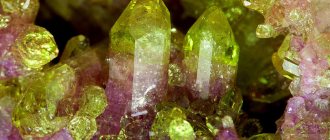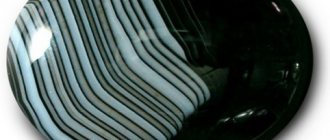Since ancient times, the zirconium stone, or zircon, as it should be correctly called, has been equated in properties and beauty to a diamond. The Persians called this mineral golden, which in their language sounded like “tsargun”. Gradually, the Asian talisman gained popularity around the world. Later, transparent crystals began to be used in jewelry as an analogue of diamond.
History's mistakes and cuckoo zircon
It is assumed that the names zircon and zirconium come from the Persian (distorted) words “tsar” - gold and “hun” - color. That is, the stone is the color of gold.
There is a version that the name of the gem comes from the Arabic “zargun” - cinnabar.
In the East, the shining stone was called the mother of the diamond or its younger brother.
For a long time (until the 18th century), Ceylon gems were brought (and bought) in Europe like diamonds. In general, the gem was mistakenly attributed to the royal family of diamonds. It was easy to make a mistake - the semi-precious stone has a shine comparable to diamond. And even fancy diamonds cannot compare with the color “assortment” of the gem. So, before the advent of instrumental methods for analyzing stones, zircon, like a cuckoo bird, was “thrown” into the nest of diamonds by human opinion.
Russian chemists already at the beginning of the 19th century called zirconium “zircon” or “zircon”.
Cost per gram
The Commonwealth of Australia and the Republic of South Africa have long been the main suppliers of zirconium to the world market. The demand for metal is constantly increasing. And the amount of supplied material remains approximately at the same level. Therefore, its cost is constantly increasing.
At the moment, the price of a gram of cinnabar is about 100-200 rubles.
Zirconium has been known to human society for a century, but it still has not revealed all its secrets to people. It is unclear why the chemical element got its name, or what the full effect of the metal on a living organism is. Probably not all sulfurs are known in which this amazing silver-colored metal can be used.
Physics and chemistry of gems
Characteristics of the mineral:
- has a resinous, glassy to diamond luster, which gives a high refractive index;
- can be transparent, translucent, opaque;
- dash color is white;
- average hardness 7.5 on the Mohs scale.
Zircons necessarily contain rare earth and radioactive elements, as well as copper, titanium, iron, zinc, and calcium.
| Color | brown in various shades, sometimes white, colorless, rarely red, green, yellow, black |
| Stroke color | white |
| Chemical formula | Zr [SiO4] |
| Shine | bold, diamond |
| Transparency | transparent, translucent |
| Cleavage | imperfect |
| Kink | conchoidal, uneven |
| Hardness | 7-8 |
| Specific gravity | 3,9—4,7 |
| Selection form | in the form of well-cut pointed crystals of long-prismatic and bipyramidal habit. The main simple forms are (110), (100), (112), (101), (211) and (331). Zircon twins are observed along (101), rarely along (111) and (211) |
| Classes on taxonomy of the USSR | Silicates |
| singonia | tetragonal |
| Additionally | yellow transparent zircon - hyacinth is transparent. P. tr. doesn't melt |
The color range of gems is quite wide. They come in various shades of brown (from yellow-brown to reddish-brown), red, green, gray or pale gray, pink. There are black and colorless crystals of the mineral.
Curious: if you are in London, go to the Natural History Museum. There is a magnificent collection of zircons collected by Sir A. Church.
Color and name
Some zircons are honored to have a personal name, and it is given according to the color of the natural mineral.
The varieties of the mineral amaze not only with their diamond shine, but also with the variety of their palette.
- For a long time, the “little brothers of diamond” were imported to Europe from one place - Ceylon (now Sri Lanka). The color scheme of the “brothers” ranges from brown-orange, through yellow to olive-green. Colorless crystals were also found (or maybe ancient craftsmen annealed the stones). Such colorless gems were called “matura diamonds.”
- Jargon, or Siamese zircon is a straw yellow, golden yellow or smoky gem.
- Hyacinth often resembles the flower of the same name in color. They are red-brown, red or brown, orange.
Earrings with hyacinth - Starlite is a bright blue stone. The appearance of natural gems is extremely rare. Almost all starlites received color by annealing brown zircons.
- Malacon. Brown-black, black gem. It has weak radioactivity.
- Green zircon does not have its own name. However, it always has radioactivity. And if pale green stones “give off” little light, then bright green ones can be dangerous if worn constantly.
Interesting: starlite got its name from the chief gemologist.
But Pliny, the author of Natural History, was not impressed by hyacinth: “Hyacinth is sharply different from... amethyst, although they are similar in color. The greatest difference is that the bright violet color, so brilliant in amethyst, is diluted in hyacinth.”
Who suits the name
You should choose a mascot based on your name. The gem is perfect for the following men:
- Vyacheslav - a stone helps to predict various events. With the help of gems it is possible to detect lies and flattery. They also warn of danger.
- Nikolay - hyacinths are suitable for owners of this name. Red zircons help you find the right path, achieve success and gain opportunities for development. With the help of the mineral, it is possible to improve your financial situation and achieve prosperity.
- Matvey - all types of crystals are suitable for people with this name. However, it is best to use varieties of warm colors - red, yellow or brown. Such talismans help you become luckier and avoid rash actions.
Women can also use the stone. The properties characteristic of the mineral are fully revealed in the owners of the following names:
- Diana - self-flowering helps women with this name become richer. The stone helps solve problems.
- Nina - in this case, the mineral helps to become more mentally stable and to endure troubles more easily. With the help of a gem you can cope with disappointments.
- Galina – the mineral will help the owners of this name to become more sociable. Thanks to this gem, you will be able to recharge with optimism and joyfully greet every day.
Where is the “mother of diamonds” used?
Don’t think that our gem is a slacker who can only show off in jewelry. Its meaning for a person is priceless.
The scope of application of the mineral includes the extraction of zirconium and hafnium from it.
Zirconium replaces expensive platinum in instrument making and in the production of spark plugs for internal combustion engines.
A rare property of zirconium is its exceptional corrosion resistance (well, it doesn’t want to rust). Products made of zirconium and its alloys are not destroyed in cold solutions of acids, alkalis, or ammonia. Sea water does not corrode this metal.
The properties of zircon stone allow it to be used in various industries.
The mineral is used to produce zirconium dioxide. It is used to produce particularly durable paints and is added to heat- and acid-resistant laboratory glassware.
The Ministry of Health has authorized the use of zirconium alloys in the manufacture of endoprostheses, implants, and dentistry.
Nowadays, real zircons are almost impossible to find in jewelry. Cubic zirconia is now usually sold under the brand name “zirconium” instead of natural gem crystals. But in ancient jewelry, natural gems are found quite often.
Ring with cubic zirconia stone
Production methods
The raw material for the industrial production of silver-colored metal was the mineral zircon. First, the mineral goes through the stage of enrichment using the gravitational method, combined with ore purification by separation (electrostatic and magnetic). This process involves sintering the concentrate with lime, calcium carbonate, and soda at high temperatures. Then remove silicon compounds from the sinter. Further decomposition with hydrochloric or sulfuric acid, obtaining zirconium from acidic solutions.
There are other ways to obtain cinnabar from zircon ores, but they are unprofitable due to their high cost.
Let's be clear
For many, zircon and zirconium are the same thing. And if we talk about cubic stabilized zirconium, then the majority will be at a dead end.
But in fact, everything is simple.
Zirconium is a metal. In the periodic table of Mendeleev (ugh, about chemistry, most will say...) a metal with atomic number 40. Write Zr to a chemist, and he will automatically read “zirconium”.
Zircon is the name of a mineral whose crystals are used in jewelry. Chemical formula of ZrSiO4. Take a closer look and you will see the designation zirconium in the formula.
Cubic stabilized zirconium, or simply cubic zirconia. A magical invention of magicians and sorcerers from the Lebedev Physical Institute. "The Poor Man's Diamond", a stone with excellent jewelry qualities. In the jewelry industry, colored artificial zircon is used as a substitute for expensive precious stones.
Important: abroad it is called zirconite.
If you see “zirctone” in the window, don’t consider it the seller’s illiteracy.
Zirkton is a brand name for synthetic corundum that is bluish-green in color. Sold as imitation sapphires.
And there is also citrine (you can read about it here), but that’s a completely different story.
Place of Birth
Zircon is most often an additional mineral that is included in the rock in very small quantities. It does not affect the general classification of the main rock and acts as an accessory mineral. Zircon is of igneous origin and is found in granites, pegmatites, and syenites.
In Russia, this mineral is found in emerald mines in the Urals and among the Yakut diamond deposits. Pure gem-quality stones are also mined in Burma, Thailand, Norway, Vietnam, Sri Lanka and the island of Madagascar.
Sorcerers from FIAN
When looking at cubic zirconia, one always remembers the Strugatsky brothers’ masterpiece “Monday Begins on Saturday.” In this book, real magicians and sorcerers worked at NIICHAVO.
The same sorcerer scientists created a “cubic stone”, cubic zirconia, at the Lebedev Physical Institute. Simple formula - zirconium dioxide, minimum price. And the result is amazing.
The main “work” of cubic zirconia is its use in jewelry.
It was called the "poor man's diamond." Low price, the possibility of adding substances that give color to cubic zirconia, diamond shine - these are the advantages of synthetic stone.
There are seven types of "poor man's diamond" color:
- when adding cerium, the resulting pebble will be red, yellow, or orange;
- add erbium - cubic zirconia will turn pink;
- can be sold for greenish sapphire if chromium is added to cubic zirconia;
- combine with a small amount of titanium - we get a stone of a golden-brown (cognac) hue;
- If the goal is to get an imitation of kunzite, sapphire, amethyst - add neodymium and get purple cubic zirconia.
Every woman wants to wear sapphires and diamonds. It's not always her fault that she doesn't have such jewelry.
But every woman can buy earrings or a ring with cubic zirconia. And feel like a goddess!
Let's refine the gem
Just heating (annealing) the stone, and what an effect! Brownish Cambodian zircons take on a stunning blue color. Connoisseurs compare it with expensive Paraiba tourmalines.
And if you burn the gem a second time, but in an oxygen atmosphere, the color will change to yellow. But yellow is different from yellow. Here you get just a piece of sun in the palm of your hand.
The sheaves of rays from the facets of the gem blind the eyes, and the gem shimmers in the sun incredibly beautifully!
Interesting: the most beautiful blue zircons are obtained by heating Cambodian gems.
Gem magic
Zircon is a stone of truth and justice. The magical properties of zircon will bring deceivers and scammers to the surface. A talisman or gem jewelry will help judges, criminologists, and scientists.
The energy of the gem is masculine. A ring with a stone of a calm color and a tie pin will well complement the image of a successful man.
The zircon stone will create all sorts of obstacles for liars and scammers, and can cause great harm in scams. In any case, initiates have been confident of this for a long time.
Moms and dads! Give your daughters earrings with zircon in yellow shades. The girl will be happy with the decoration, and the magic of the mineral will increase perseverance and diligence in her studies. That's what the esotericists say.
From ancient times to the present day in India, girls wear zircon stones. They are sure that the amulet will protect against temptations and (since it did not protect) from unwanted pregnancy.
Esotericists believe that excessive fatness is a disorder in the physical and spiritual parts of a person. The energy of the mineral brings both of these parts into balance. Therefore, overweight people are advised to wear a pendant or pendant made of gems.
Medicinal properties
The healing properties of the stone are due to the unusual shape of the crystals. Thanks to this, it accumulates vital energy. The gem is able to absorb or give it away.
The mineral helps improve the functioning of the nervous system. In case of ischemia, the stone allows you to reduce the frequency and severity of attacks. For this, it is recommended to use a pendant or necklace.
Therapeutic characteristics may vary depending on the shade:
- Yellow crystals help improve the functions of the pancreas, liver, and gall bladder. With their help, it is possible to normalize bile synthesis and improve its composition. The mineral helps treat poisoning and cleanses, removes toxins and toxic substances.
- Dark brown gems are good for treating respiratory problems. They help alleviate sinusitis, bronchitis, pneumonia and speed up recovery. The crystal should also be worn during flu epidemics for preventive purposes.
- Hyacinths are considered the most powerful variety of zircon. With their help, it is possible to normalize the functions of the heart and blood vessels. Crystals also promote recovery from traumatic injuries. It is best to wear a ring with a crystal. Moreover, it should be put on the middle finger of the left hand.
- Transparent crystals activate metabolic processes and accelerate the process of losing weight.
Help with treatment
Lithotherapists are confident that the healing properties of the mineral help heal nervous disorders and cope with mental problems.
It has long been believed that the stone alleviates the condition of patients with coronary heart disease.
Anesthesia, intoxication during poisoning - zircons can cope with this (as esotericists say). It is useful to wear earrings with the “little brother of the diamond” for vision problems.
Stones of different colors “work on different diseases”:
- blue - speed up metabolism, help cope with constipation, reduce appetite, promote weight loss;
- dark red and black will help cope with colds;
- yellow and yellow-red help the liver function and drive away nightmares.
Of all the zircons, lithotherapists consider hyacinth to be the most powerful.
The healing effects of natural crystals
Experts studying the influence of various minerals on the human body have noticed that zircon is beneficial in many matters related to maintaining health. The effect of stones depends on their color:
- Transparent ones help relieve nervous tension, strengthen the immune system, and eliminate excess weight.
- Dark brown and rich reds protect against colds during the cold season.
- Black zircons restore the body during various infections of a viral and bacterial nature.
- Pink and orange get rid of toxins, help normalize digestion and blood circulation.
- Yellow ones restore appetite, improve the functioning of the gastrointestinal tract and biliary system. They save the owner from bad dreams.
- Blue helps restore vision.
- Rings with scarlet zircons or individual minerals without a frame are worn by the fairer sex on their hands or in their pockets to get rid of excess hair on the body.
All shades of the stone contribute to the restoration of the human energy field and the body’s resistance to various diseases.
Astrology
The patron planets of the mineral are the Sun and Saturn.
For Capricorns, zircon is a lucky find. Representatives of this zodiac sign can collect a whole collection of gems of different colors. Each pebble will give Capricorn its help.
The mineral has a light disposition:
- Sagittarius;
- Aquarius;
- Scales;
- Aries;
- Taurus.
The gem will easily make friends with these signs. You just need to choose the right color:
- Aquarians can choose colorless, yellow, blue, golden colors.
- Capricorn will receive the best help from yellow and blue stones. But gems of a different color will go very well with it.
- Aries - the fiery lamb - will like jewelry with red and golden gems.
Cancers and Pisces should either not wear zircons, or wear them infrequently - the stone is not suitable for these zodiac signs.
Magic properties
Zircon is a stone characterized by magical properties. With its help, it is possible to improve memory and attention. The mineral develops intuition and attracts well-being. Crystals help you learn to identify lies and hypocrisy.
In this case, the properties may differ slightly depending on the shade:
- Red and yellow stones help bring good luck to explorers. Today they are often used by businessmen, scientists, and inventors.
- Black stone helps to hide important information from strangers. Therefore, such decorations were often used by the creators of secret organizations.
Although the gem is more suitable for men, it can also be given to girls. Thanks to this crystal, you will be able to get rid of the tendency to panic. With its help, you can learn to perceive the situation soberly and make the right decisions.
Let's preserve zircon in all its glory
Caring for a gem is easy.
Zircon is a fragile stone. Do not apply mechanical force to it, drop it, or scratch it.
If you buy jewelry with the “mother of diamonds”, make sure that the stones are in special, high frames.
The gem does not tolerate household chemicals. So before washing dishes or washing, the ring with the zircon insert will have to be removed.
It is better to wash contaminated jewelry in warm water with baby (neutral) soap. Rinse under running water, dry carefully with a cloth.
Store jewelry with zircons separately from other jewelry. In bags made of soft, thick fabric, in cases, boxes or caskets, lined with soft (velvet, plush) material on the inside.
Artificial option
This relative of the noble diamond has a cheaper version created in a laboratory. Cubic zirconium is used to create budget jewelry. The price of such jewelry is several times lower than products with natural gems. The second name for artificial crystal is cubic zirconia.
The following properties of stone from the laboratory are distinguished:
- High strength, thanks to which cubic zirconium does not lose its appearance under mechanical stress.
- Excellent light refractive index, but if worn for a long time, the jewelry may lose its original shine.
- Stones do not change when exposed to heat or chemicals other than chlorine.
- Synthetic crystals are easy to color, giving them different shades.
Cubic zirconium does not have its own energy, since it appeared artificially. It is generally accepted that the mineral absorbs the emotions of the owner and stores them within itself. For this reason, jewelry with cubic zirconia is not recommended to be worn during periods of strong emotions and adversity.
Counterfeits, imitations, synthetics
A natural mineral suitable for jewelry is becoming increasingly rare. To be honest, you can hardly find it in jewelry stores. But there are a lot of artificial stones.
Let's try to find the difference between a natural gem and zircon:
- A magnifying glass will help you. Let's take a closer look at the stone. In the present there will always be inclusions, voids and other traces of natural origin. Synthetic stone does not have such traces.
- Sometimes a natural gem is weakly radioactive. There is a device for determining radioactivity - measure the background from the stone.
- Zircon looks and shimmers like a real diamond. But only where there are inclusions or a resinous tint.
Red gems with a purple tint can be passed off as high-quality amethyst. Green zircon is sometimes passed off as demantoid, chrysolite, even emerald. Blue can be sold as sapphire. Although the properties of these stones have strong differences.
Origin of the stone
What is zircon? This is, first of all, one of the most ancient stones on our planet. For example, scientists once discovered a specimen in Australia that is 4.4 billion years old—almost as old as the Earth.
This is one of the most ancient minerals on the planet.
Previously, the stone was constantly confused with various other gems: chrysoberyl, tourmaline, amber. Dishonest traders even passed off transparent specimens of the mineral as diamonds. However, no one has studied the properties of the stone itself.
The inhabitants of Europe were able to appreciate this gem only in the fifteenth century. Brown-red crystals were called hyacinths, honey-gold ones were called jargons, and blue ones were called starlites. The first zircon sets and jewelry appeared, which were popular with the nobility.
During the Soviet era, zircon faced another problem. When artificial diamonds and cubic zirconia were grown at the Lebedev Physical Institute of the Russian Academy of Sciences, their other name, Zirconia, took root in the West. Since laboratory gems are “dead” from the point of view of magic, American and European psychics did not use cubic zirconia. Due to the similarity of the name, many confused them with zircons. There is a common misconception that crystals are useless.
